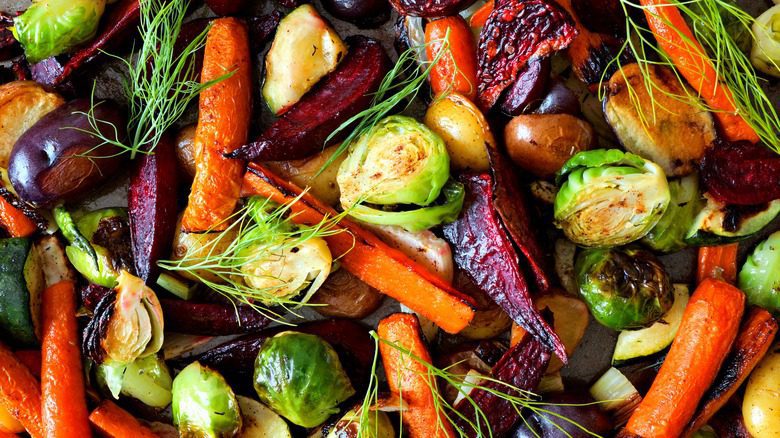
Imagine this: you’ve got a bunch of vegetables sitting in your fridge, and you’re not quite sure what to do with them. You want something simple, yet flavorful, and you want to bring out the natural sweetness of those veggies. That’s where roasting comes in. Whether you use an oven, air fryer, or convection oven, roasting is the key to achieving perfectly browned, crispy-skinned vegetables with a tender, honeyed interior. But have you ever wondered why roasted vegetables taste sweeter? It’s all about the caramelization process. Roasting helps release the natural sugars in vegetables, resulting in a deliciously sweet and nutty flavor. In this article, we’ll explore why roasting works its magic and provide some tips on how to roast vegetables to perfection. Prepare to elevate your vegetable game and unlock a whole new world of deliciousness.
Why Roasted Vegetables Taste Sweeter & How To Do It Right
The Caramelization Process
Roasting vegetables is a great way to bring out their natural sweetness and enhance their flavors. The key to this transformation lies in the caramelization process. When vegetables are roasted at high heat, the natural sugars in them begin to break down and undergo a series of chemical reactions. This process, known as caramelization, results in the browning of the vegetables and the development of a rich, sweet flavor.
Difference between Caramelization and Maillard Reaction
It’s important to note that caramelization is different from the Maillard reaction, another browning process that occurs when proteins and sugars react at high temperatures. While both processes contribute to the flavors of roasted vegetables, caramelization specifically involves the breakdown of sugars in the absence of proteins. This distinction is what gives roasted vegetables their unique sweetness.
Caramelization Temperature
Different sugars caramelize at different temperatures. Sucrose and glucose, for example, begin to caramelize at around 320 degrees Fahrenheit, while fructose caramelizes at a lower temperature of 230 degrees Fahrenheit. This means that the caramelization process can occur within a wide range of temperatures, depending on the specific sugars present in the vegetables being roasted.

This image is property of www.chowhound.com.
Formation of Aromatic Compounds
As the sugars in the vegetables caramelize, they undergo further chemical reactions that lead to the formation of aromatic compounds. These compounds contribute to the complex flavors and aromas that make roasted vegetables so delicious. The result is a sweet, nutty, and toasty flavor that is highly desirable.
Best Vegetables for Roasting
Not all vegetables are created equal when it comes to roasting. Some vegetables are naturally sweeter than others and contain higher levels of sugars. Root vegetables such as beets, carrots, parsnips, and turnips are excellent choices for roasting due to their high sugar content. Squash and tubers like sunchokes and rutabagas are also great options. These vegetables not only caramelize beautifully but also have a lovely texture when roasted.
Sugar Content of Vegetables
The sugar content of vegetables plays a significant role in their taste when roasted. Vegetables with higher sugar content will naturally taste sweeter when caramelized. In contrast, vegetables with lower sugar content may not develop the same level of sweetness. Understanding the sugar content of the vegetables you are roasting can help you choose the right ones to achieve the desired flavor.
Texture of Roasted Vegetables
Roasting vegetables not only enhances their flavors but also changes their texture. The high heat of the oven causes the vegetables to soften and develop a tender interior while creating a crispy, caramelized exterior. It’s important to find the right balance between cooking the vegetables long enough to achieve tenderness and avoiding overcooking them, which can result in a mushy texture.
Preparation and Serving Suggestions
When it comes to preparing roasted vegetables, the possibilities are endless. Once your vegetables are roasted to perfection, you can enjoy them in various ways. They make an excellent side dish, either on their own or mixed with other ingredients. You can also use them as a component in an entree or as a topping for salads and grain bowls. Get creative with your seasonings and consider adding herbs, spices, or a drizzle of balsamic vinegar for extra flavor.
Tips for Roasting Vegetables
To ensure that your roasted vegetables turn out perfectly every time, here are some helpful tips:
-
Preheating the Oven: Preheat your oven to a high temperature, preferably between 425 and 450 degrees Fahrenheit. This high heat is crucial for achieving that desirable caramelization and crispiness.
-
Choosing the Proper Vessel: Opt for a sheet pan when roasting vegetables. Glass baking dishes are not as effective at conducting heat, and high-sided pans can trap steam, preventing the vegetables from browning evenly. To make cleanup easier, consider lining the tray with aluminum foil or parchment paper.
-
Size of Vegetable Chunks: Cut your vegetables into roughly 1-inch chunks for even cooking. It’s important to ensure that the pieces are uniform in size to prevent some from undercooking while others become overdone.
-
Keeping Vegetables Dry: Pat your vegetables dry before roasting them. Excess moisture can cause the vegetables to steam rather than roast, resulting in a less crispy texture.
-
Avoiding Overcrowding: Give the vegetables enough space on the baking sheet to allow air to circulate properly. Overcrowding the pan can cause the vegetables to steam instead of achieving that desired caramelization.
-
Coating with Olive Oil: Toss your vegetables in a generous amount of olive oil to ensure that they achieve a crispy, caramelized exterior. The oil also helps to enhance the flavors of the vegetables.
-
Seasoning and Spices: Experiment with different seasonings and spices to add depth and complexity to your roasted vegetables. Garlic powder, smoked paprika, dried herbs, and other spice blends can take your dish to the next level.
-
Avoiding Adding Sugar Too Early: While the caramelization process naturally brings out the sweetness in vegetables, there is no need to add additional sugar. Adding sugar too early in the cooking process can result in burnt or overly sweet vegetables.
-
Checking and Turning Vegetables: Keep an eye on your vegetables as they roast to prevent them from burning. Depending on their size and the oven temperature, vegetables can cook at different rates. Turn the vegetables about halfway through the cooking time to ensure even caramelization on all sides.
By following these tips and understanding the science behind caramelization, you can confidently roast vegetables that are perfectly sweet, tender, and flavorful. Let your creativity soar as you experiment with different vegetables, flavors, and serving suggestions. Enjoy the transformation of these humble ingredients into a delightful culinary experience. Happy roasting!






